South Dakota Highway Patrol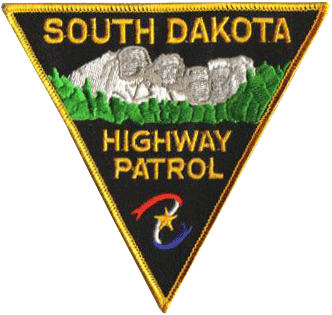
South Dakota Highway Patrol
In 1935, the Governor of South Dakota, Tom Berry, recognized the need for an organization to enforce the traffic laws and provide assistance to the motoring public.
Governor Berry appointed ten men that were known as the "Courtesy Patrol". These men were tasked with enforcing all the laws in South Dakota and helping to inform the public about the states emerging traffic regulations. Each man was given a car, affectionately called a "milk wagon", a tow chain, a first aid kit, and a gallon of gasoline. The new officers were assigned to patrol the 2,000 miles of hard surfaced roads and 4,000 miles of gravel highways.
The Courtesy Patrol rules required them to stop and aid all motorists on the highway. If the motorist was changing a tire, the patrolman stopped to help. He never left a stalled automobile until the driver was safely on his way. The legislature abolished the Department of Justice in 1937 and the authority for the Highway Patrol was transferred to the Highway Department.
The Courtesy Patrol was disbanded and the new Motor Patrol was founded. 1958 saw a record 240 people die on South Dakota roads. By executive order, various colored and unmarked patrol vehicles were utilized for a time to help reduce the death toll from traffic accidents. The port of entry system was started on a trial basis.
As the 1960's began, there was an expansion of the port of entry inspection stations and top mounted police lights on patrol cars were seen for the first time and two-tone SDHP patrol cars shortly followed. In 1967, the Motor Vehicle Safety Inspection Program commenced, and more troopers were hired. In 1974, the governor saw fit to authorize the hiring and training of 75 new SDHP officers. Shortly thereafter, the district concept was reorganized and vast improvements were made in the administration of the Patrol.
As time marched on into the new millennium, the mission of the Highway Patrol continued to be DUI interdiction, drug enforcement and accident prevention. Since its inception in 1938, the South Dakota Highway Patrol moved from a reactive organization to a proactive group of men and women who anticipate changes in highway safety and enforcement techniques.
The Patrol has matured into a professional law enforcement agency prepared to respond to the ever changing needs of the public it serves. The 157 members of the Highway Patrol wear the uniform and badge with pride and distinction.
The earliest recorded information about the use of license plates on South Dakota Highway Patrol cars was in 1936. A period photograph depicting a new all-white sedan marked with a circular door emblem denoting the South Dakota Department of Justice with MOTOR PATROL above it shows a 1936 South Dakota Tax Exempt license plate number 78 affixed to the front of the car.
In 1938 a photo was taken depicting a fleet of all-white SDHP cars and showing embossed steel "State Tax Exempt" license plates with registration numbers between 357 and 365 affixed to the new cars.
The state tax exempt license plates were of the same annual construction, layout and color scheme as regular passenger car license plates of the day.
It is not known if the number blocs used by the SDHP at that time were random or reserved.
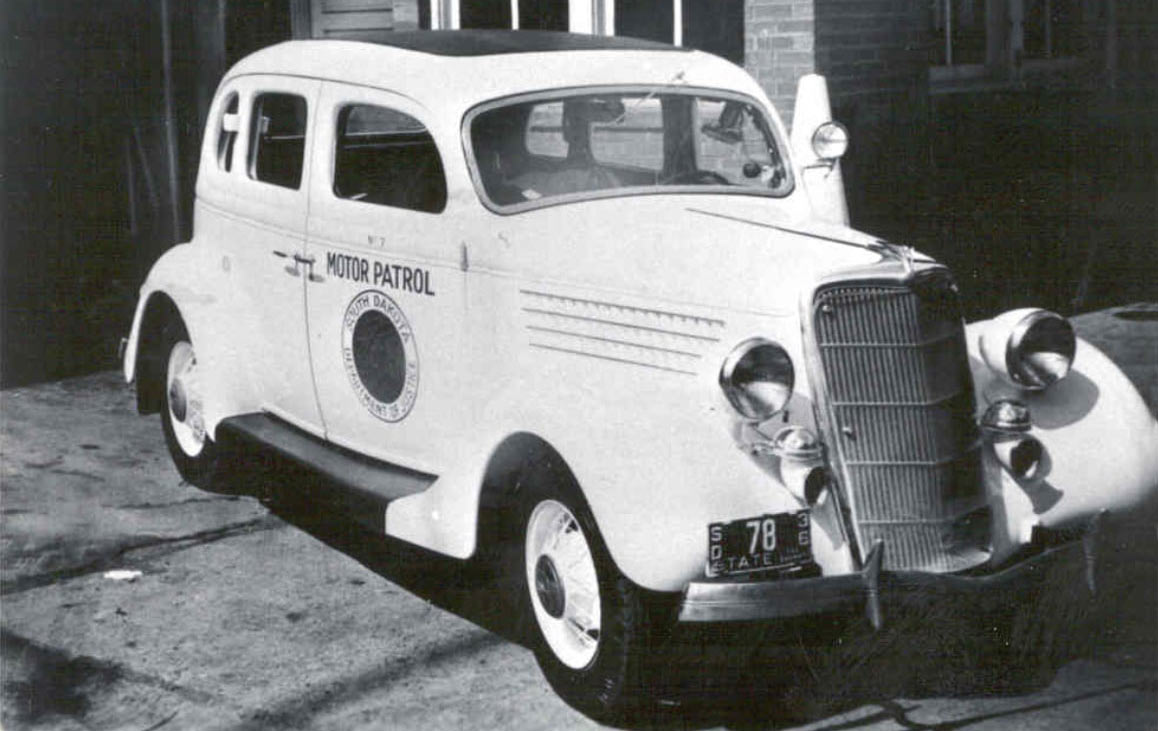 1936 Department of Justice Motor Patrol.
1936 Department of Justice Motor Patrol.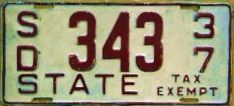 1937 State Tax Exempt Issue.
1937 State Tax Exempt Issue. 
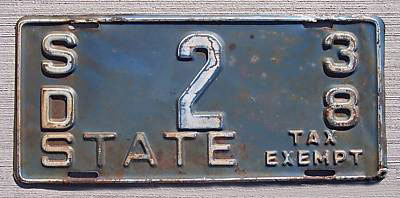 1938 State Tax Exempt Issue.
1938 State Tax Exempt Issue. 
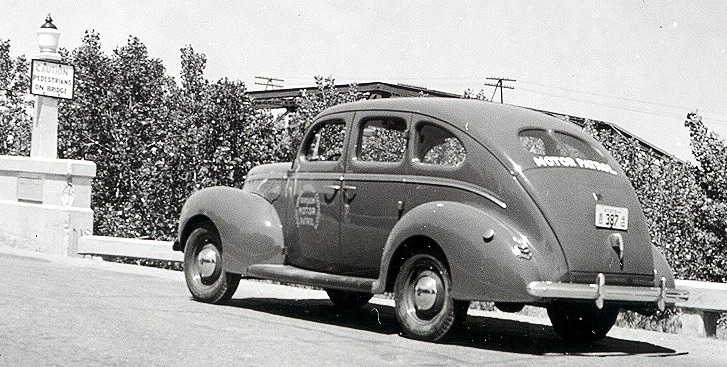
1939: Embossed steel with border. 5 1/2" x 11". Royal blue over white. STATE (over) SD (stacked) ### 39 (stacked)
1940: Embossed steel with border. 5 1/2" x 11". Black over yellow. STATE (over) SD (stacked) ### 40 (stacked)
1941: Embossed steel with border. 5 1/2" x 11". Yellow over black. STATE (over) SD (stacked) ### 41 (stacked)
1942: Embossed steel with border. 5 1/2" x 11". Black over yellow. STATE (over) SD (stacked) ### 42 (stacked)
1943: 2 1/4" diameter "43" metal tab used on passenger plates to re-validate 1942 license plates.
1944: Green, black and white windshield decal used to revalidate 1942 license plate.
1945: Green over white windshield decal used to revalidate 1942 license plate.
1946: Embossed steel with border. 5 1/2" x 11". White over black. STATE (over) SD (stacked) ### 46 (stacked)
1947: Embossed aluminum with border. 5 1/2" x 11". Black over aluminum. STATE (over) SD (stacked) ### 47 (stacked)
1948: Embossed aluminum with border. 5 1/2" x 11". Red over aluminum. STATE (over) SD (stacked) ### 48 (stacked)
1949: Embossed aluminum with border. 5 1/2" x 11". Blue over aluminum. STATE (over) SD (stacked) ### 49 (stacked)
1950: Embossed steel with border. 5 1/2" x 11". Black over orange. STATE (over) SD (stacked) ### 50 (stacked)
1951: Embossed steel with border. 5 1/2" x 11". Orange over black. STATE (over) SD (stacked) ### 51 (stacked)
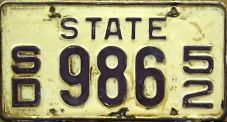 1952 State Tax Exempt Issue.
1952 State Tax Exempt Issue. 
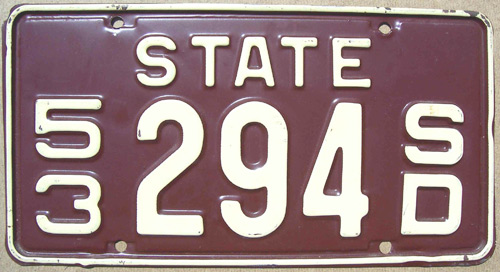 1953 State Tax Exempt Issue.
1953 State Tax Exempt Issue. 
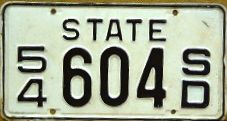 1954 State Tax Exempt Issue.
1954 State Tax Exempt Issue. 
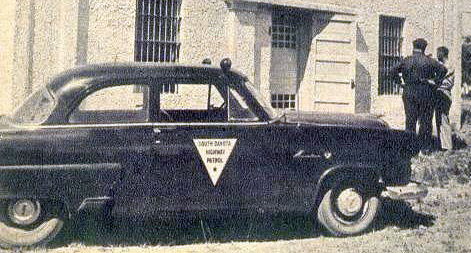
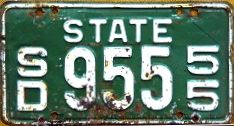 1955 State Tax Exempt Issue.
1955 State Tax Exempt Issue. 
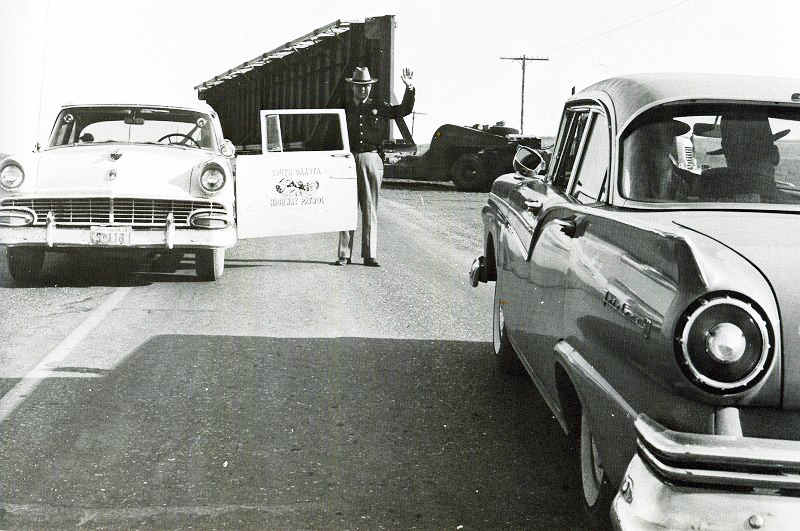
 1956 State Vehicle issue. Embossed steel.
1956 State Vehicle issue. Embossed steel.
In 1957, the state of South Dakota introduced its first multi-year license plate. Plates used by the South Dakota Highway Patrol for that year through the end of 1959 were made of embossed steel and colored black over reflective white. The state name occupied most of the upper portion of the plate with 57 embossed at the top right corner. It was flanked by two slits on either side of the 57 which were receivers for validation tabs for 1958 and 1959.
The 1958 tab was colored orange over maroon and the tab for 1959 was colored black over red.
The plates held-up quite well given a three year "road life".
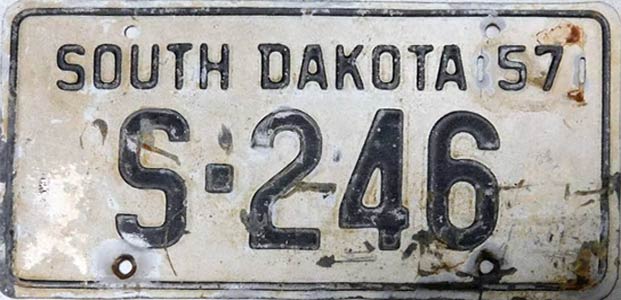 1957-1959 State Tax Exempt Issue. Embossed steel.
1957-1959 State Tax Exempt Issue. Embossed steel.
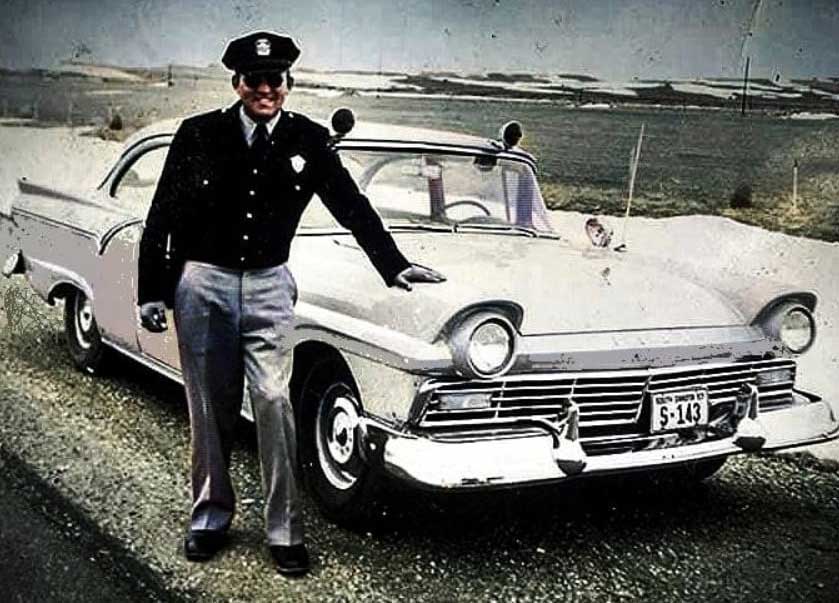 1957. Number 146
1957. Number 146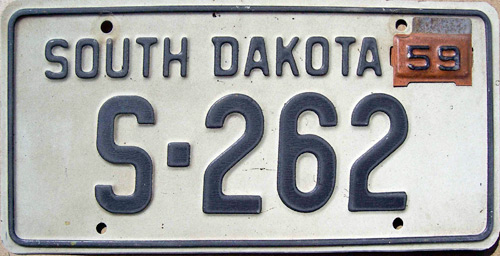 1957-1959 State Tax Exempt Issue. Embossed steel.
1957-1959 State Tax Exempt Issue. Embossed steel.
There is absolutely no information with respect to South Dakota Highway Patrol license plates for the early 1960's. If we are to surmise that the same pattern for state tax exempt license plates continued to mirror the passenger car plates of the day, they would have appeared as such:
1960: Embossed steel with border. 6" x 12". Black over reflective tan. SOUTH DAKOTA 60 over S-###
1961: Embossed steel with border. 6" x 12". Green over reflective white. SOUTH DAKOTA 61 over S-###
1962: Embossed steel with border. 6" x 12". Black over reflective white. SOUTH DAKOTA 62 over S-###
1963: Embossed steel with border. 6" x 12". Red over reflective white. SOUTH DAKOTA 63 over S-###
1964: Embossed steel with border. 6" x 12". Blue over reflective white. SOUTH DAKOTA 64 over S-###
It was around 1965 when a multi year state tax exempt license plate was introduced for use by the South Dakota Highway Patrol. The plate was made of embossed steel and colored red over reflective white. The abbreviation S.DAK. was embossed in the top left corner of the plate and TAX over EXEMPT in the small dies as seen on the issues that came out in the 1930's was placed just below the upper right mounting hole.
A registration number in the same S-### format was used again with no known reserved number blocs for SDHP.
By 1968, the same base plate was still used by the SDHP, however the prefix SP was used prior to the dash and assignment number. This type was used until around the conclusion of 1970.
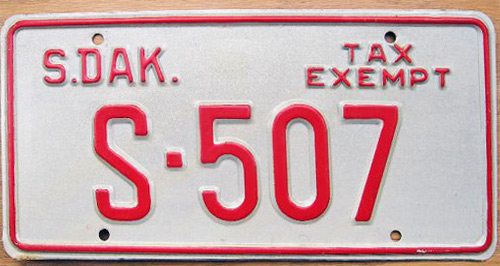 Circa 1965-1967 State tax exempt issue. Embossed steel.
Circa 1965-1967 State tax exempt issue. Embossed steel.
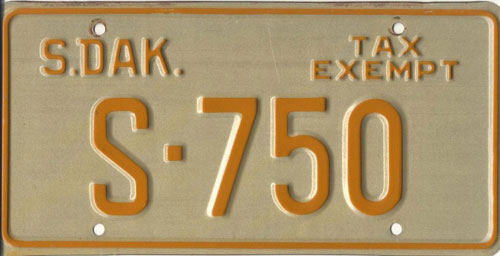 Circa 1965-1967 State tax exempt issue. Embossed steel.
Circa 1965-1967 State tax exempt issue. Embossed steel.
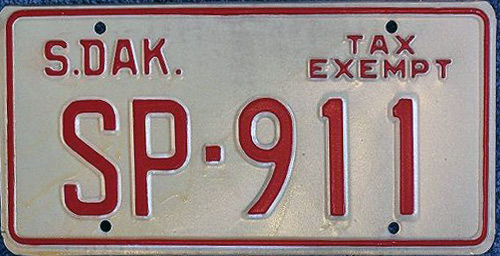 1968-1970 State tax exempt issue. Embossed steel.
1968-1970 State tax exempt issue. Embossed steel.

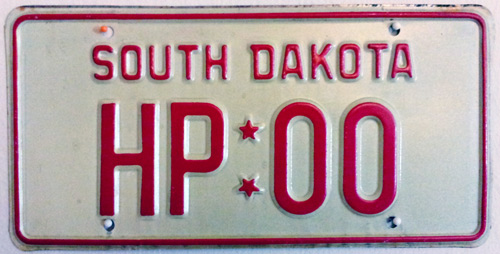 1971-1973 sample issue.
1971-1973 sample issue. 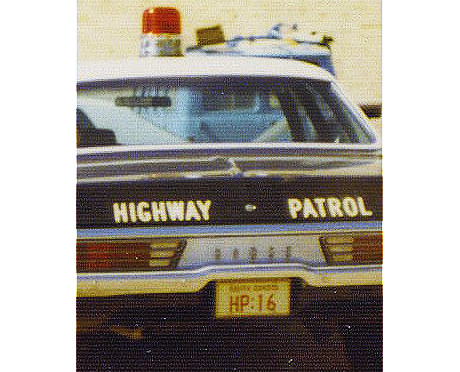
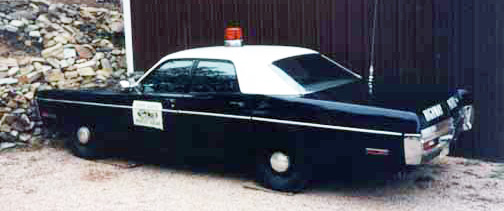
Around 1974, South Dakota Highway Patrol license plates changed again. This time going to a black over reflective white embossed galvanized steel plate. The state name was spelled out in full across the top of the plate just below the upper mounting holes. The HP prefix continued to be used with the "stacked stars" hyphen followed by the assignment number.
It was around this time that the assignment numbers went into the triple digits.
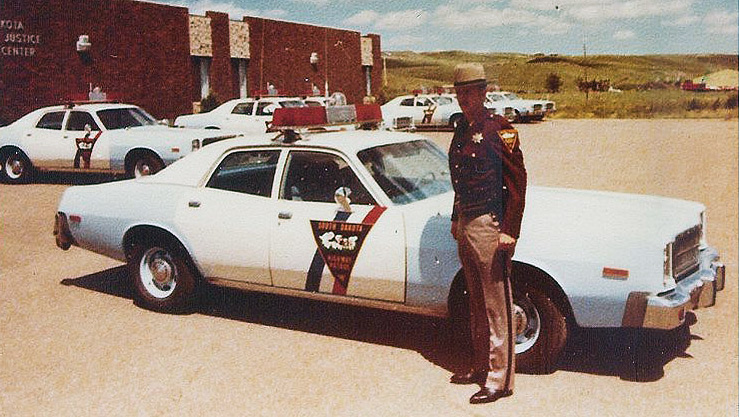
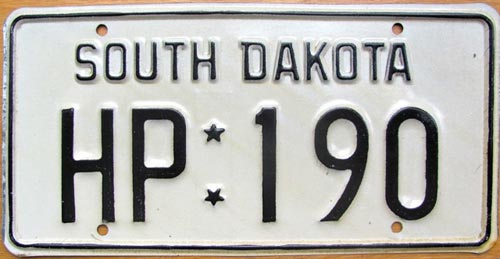 1974-1978 issue.
1974-1978 issue. 
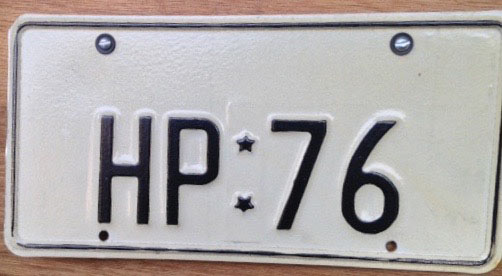 Circa 1974-1978 issue.
Circa 1974-1978 issue. 
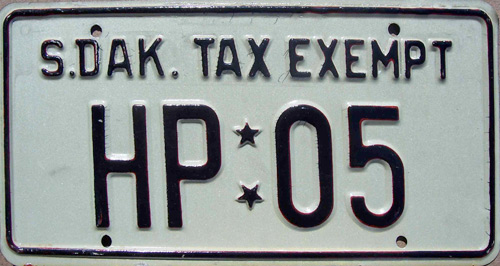 1978-1981 issue. Embossed steel.
1978-1981 issue. Embossed steel.
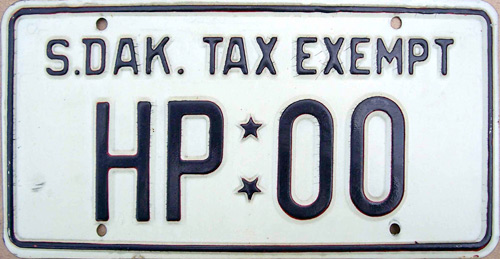 1978-1981 sample issue.
1978-1981 sample issue.
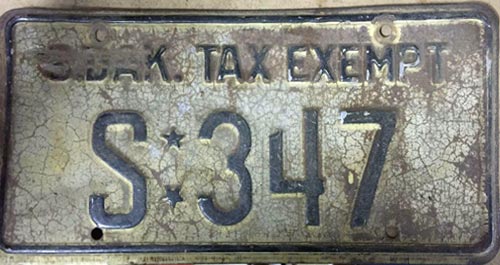 1978-1981 State vehicle issue.
1978-1981 State vehicle issue.
In 1978, the TAX EXEMPT monicker and abbreviated state name at the top of the plate was returned. The HP prefix followed by the two stacked embossed stars and number up to three digits continued. This type was used until 1981 when a new graphic style license plate for the South Dakota Highway Patrol was launched.
The new plate was made of embossed galvanized steel, but introduced an attractive red silkscreen graphic for the state name and an image of Mount Rushmore along the bottom section of the plate. This looked striking against the reflective white background and the embossed characters in blue. The plate had a rectangular recess or "navel" at the top center between the upper mounting holes. On regular South Dakota license plates during this time, was a decal indicating the name of the county in which the license plate was issued. For the SDHP in some instances, a white decal with the SDHP district number in red was applied on this void. Not all SDHP plates used the District Number decals.
Motor Carrier officers used the same plates on their patrol vehicles with the excpetion of an MC prefix ahead of the assignment number.
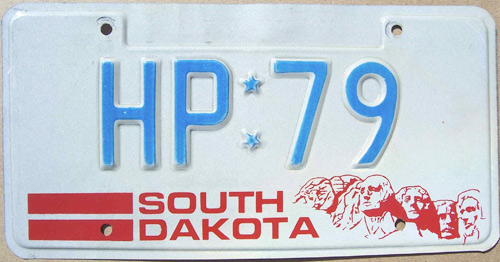 1981-1988 issue.
1981-1988 issue. 
 1981-1988 issue with 1982 date and District decal.
1981-1988 issue with 1982 date and District decal. 
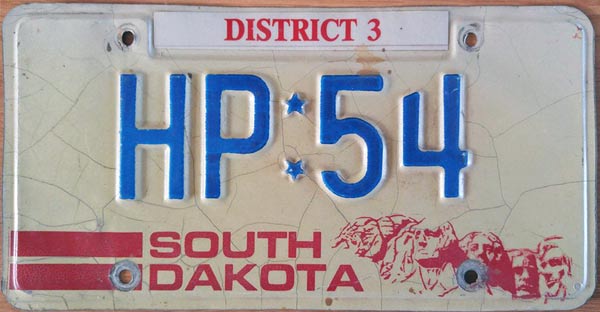 1981-1988 issue.
1981-1988 issue. 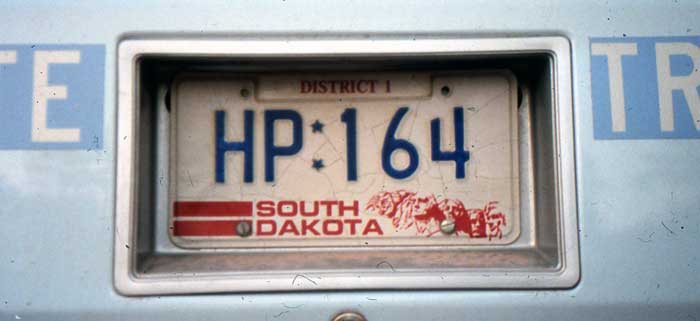 (Courtesy Jack McGee)
(Courtesy Jack McGee) 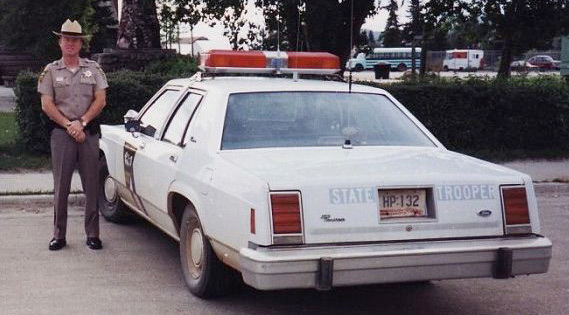
In 1988, the South Dakota Highway Patrol celebrated its 50th Anniversary. In commemoration of this Golden Anniversary, the SDHP introduced a special license plate to be used on all marked patrol vehicles. The plate was entirely silkscreened with the only embossing being the step border around the plate itself.
The background was reflective white. As the state of South Dakota was also embarking on its centennial of statehood the following year, the bottom of the plate had the state name silkscreened in red utilizing a stylized font with 1889-1989 in the bottom center and the image of Mount Rushmore in the bottom right corner also screened in red.
The top of the plate had blue silkscreened characters with 50 YEARS (over) OF SERVICE in the top left corner, HIGHWAY PATROL screened in the top center and an inverted blue triangle with 50 in gold over a blue rectangular outline with 1938 1988 on either side of the triangle base.
The HP prefix and assignment number were silkscreened in blue with a stylized state centennial gold star with red and blue ribbon screened as the hyphen.
These plates were run for one year until the 50th Anniversary was over.
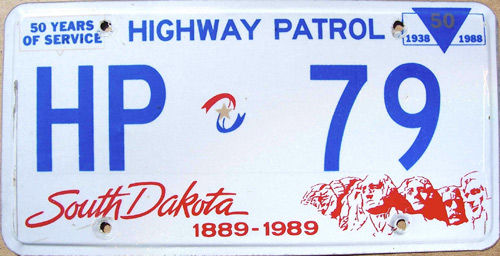 1988-1989 50th Anniversary issue.
1988-1989 50th Anniversary issue. 

After the completion of the Golden Anniversary in 1989, the 50th Anniversary license plates were replaced with a new plate using the same silkscreened graphics as the previous issue but minus the 1889-1989 graphic. In addition, the HP prefix, stacked star hyphen and assignment numbers were embossed once again.
By late 1990 into 1991, the state of South Dakota spiced-up the red graphic script for the state name on its license plates and introduced a more "clean" graphic for Mount Rushmore.
This style was used through to 2000.
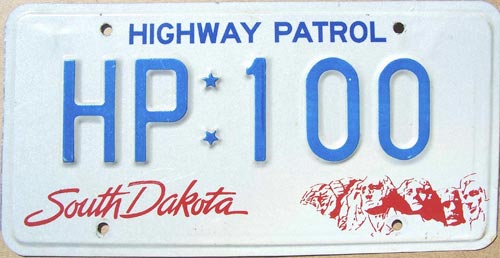 1989-1990 issue.
1989-1990 issue. 
 1989-1990 issue
1989-1990 issue
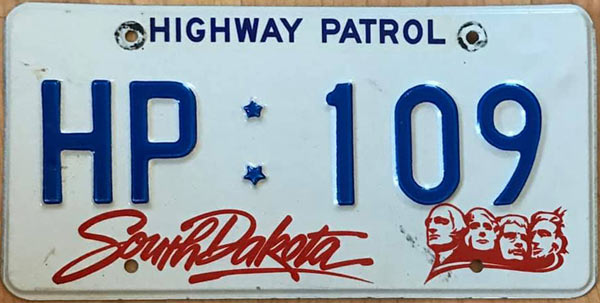 c.1991-2000 issue. Embossed steel.
c.1991-2000 issue. Embossed steel.
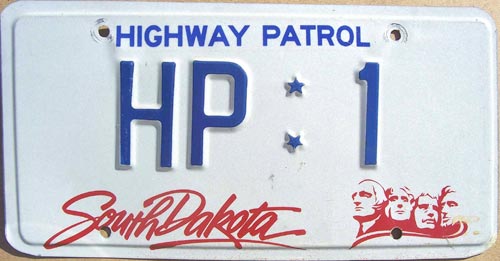 c.1991-2000 issue.
c.1991-2000 issue. 
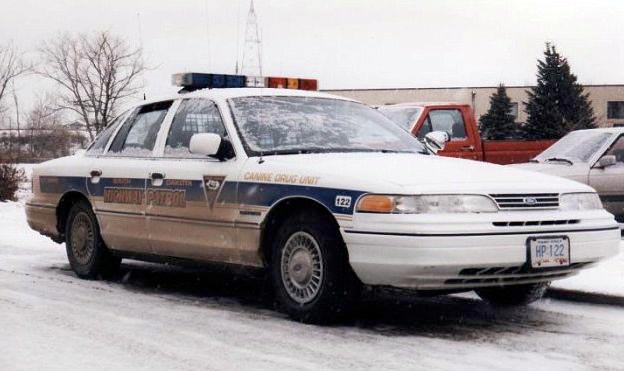
In 2000, the state of South Dakota re-plated all vehicles in the state with a whole new red white and blue graphic design. The embossed steel license plates featured a red band that ran the horizontal length of the top portion of the otherwise reflective white license plate. The state name was silkscreened in white between and just below the upper mounting holes.
The bottom portion of the plate featured a blue silhouette of the Black Hills and a stylized motif depicting Mount Rushmore in the center. A blue decal with HIGHWAY over PATROL in white was applied in the bottom right corner. A full color emblem of the SDHP shoulder patch occupied the left center field of the plate followed by the embossed HP prefix and the assignment number.
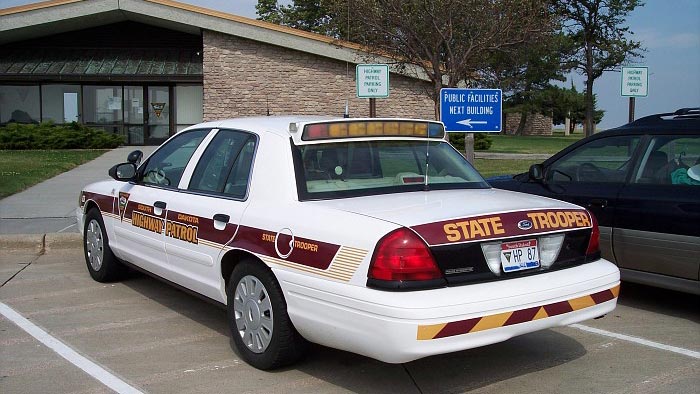
 2000-2013 issue. Embossed steel.
2000-2013 issue. Embossed steel.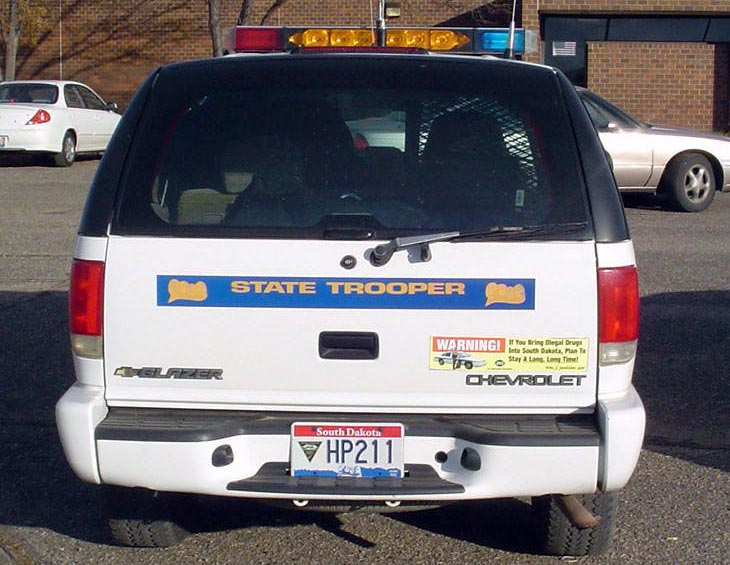
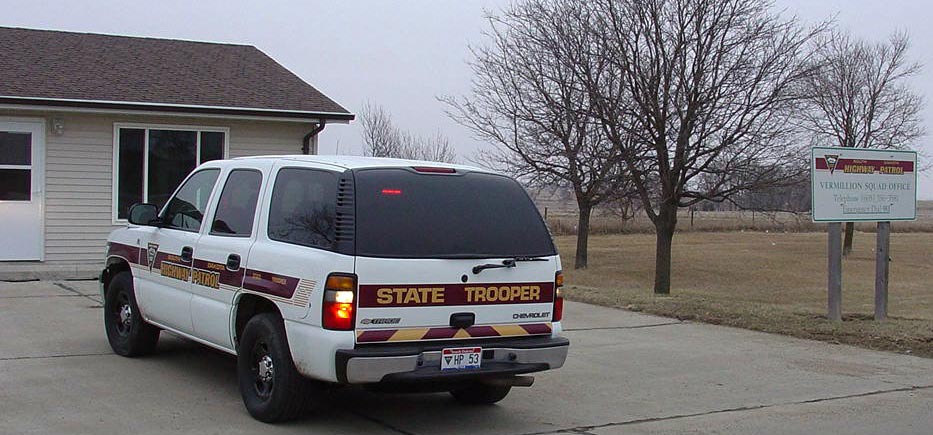
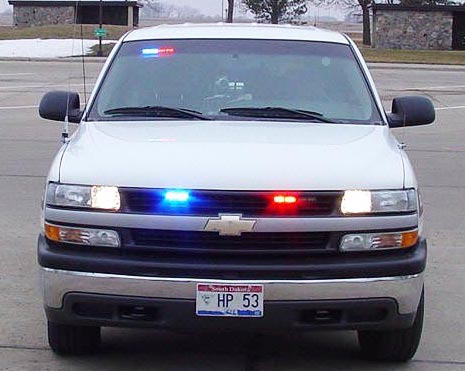
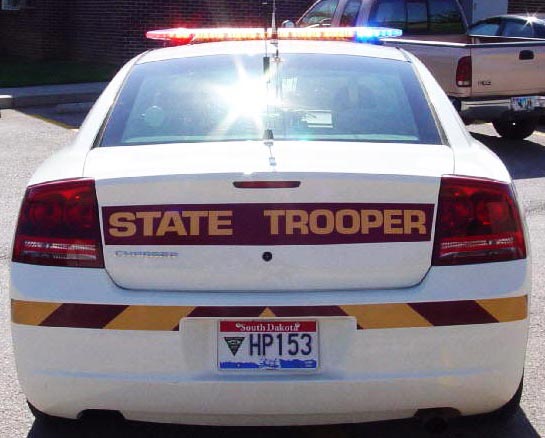
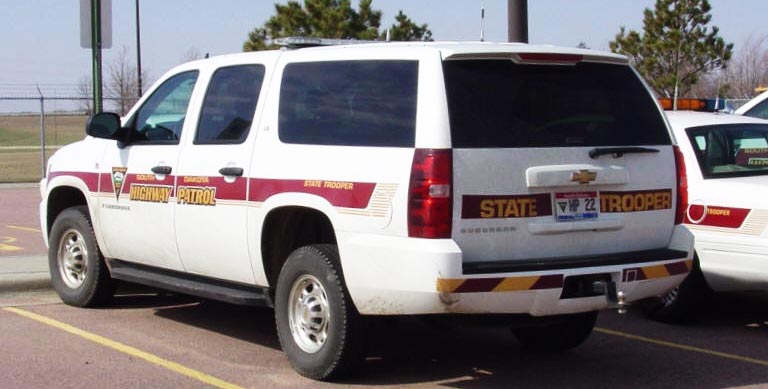
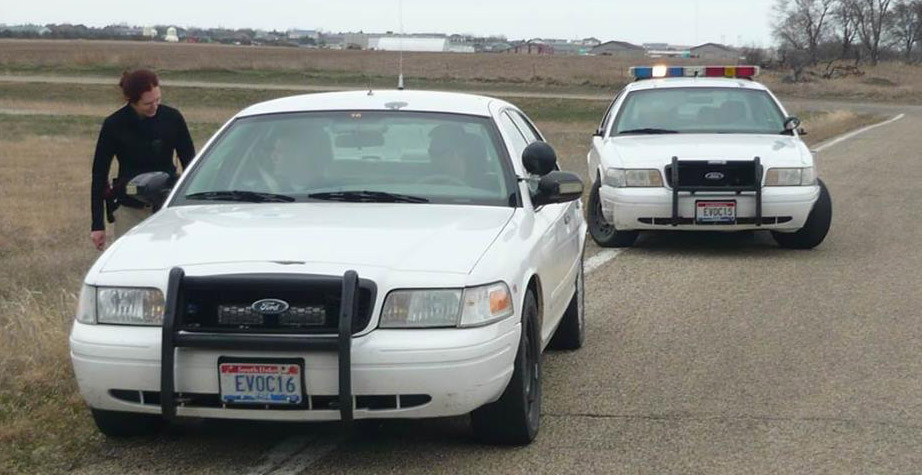 SDHP Emergency Vehicle Operators Course (EVOC) issues used on training vehicles.
SDHP Emergency Vehicle Operators Course (EVOC) issues used on training vehicles.By sometime around 2009, the state of South Dakota began to silkscreen registration numbers on their license plates. License plates for the South Dakota Highway Patrol soon followed suit. The plates were still identical in layout and color scheme as the earlier version, however the only change was that the HP prefix and the assignment number were also silkscreened, rendering the entire plate flat.
Of note too is that the font used for the HP prefix in these early all-flat plates was thicker than the font used for the numbers.
 2009-2013 issue. Silkscreened steel.
2009-2013 issue. Silkscreened steel.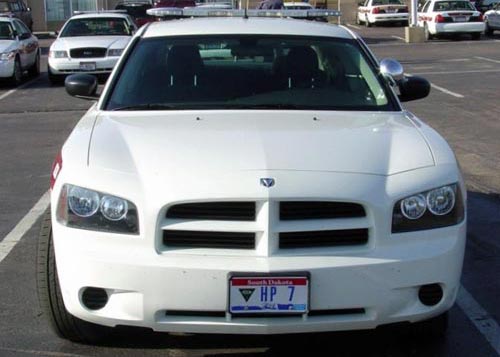 Chunky font style.
Chunky font style.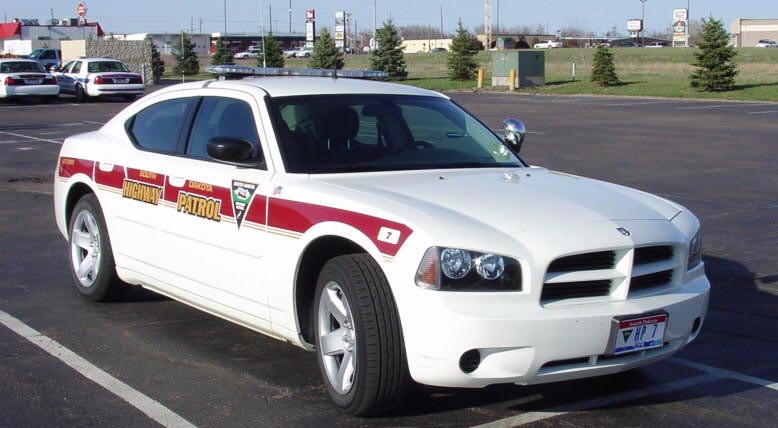
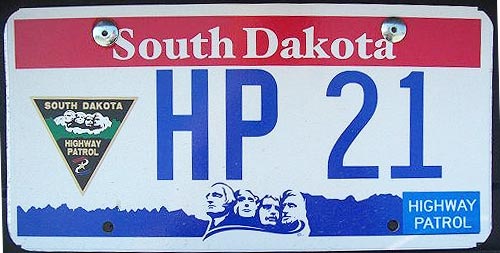 2009-2013 issue. Silkscreened steel.
2009-2013 issue. Silkscreened steel.
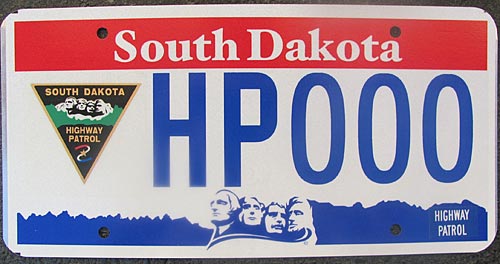 2009-2013 Sample issue.
2009-2013 Sample issue. 
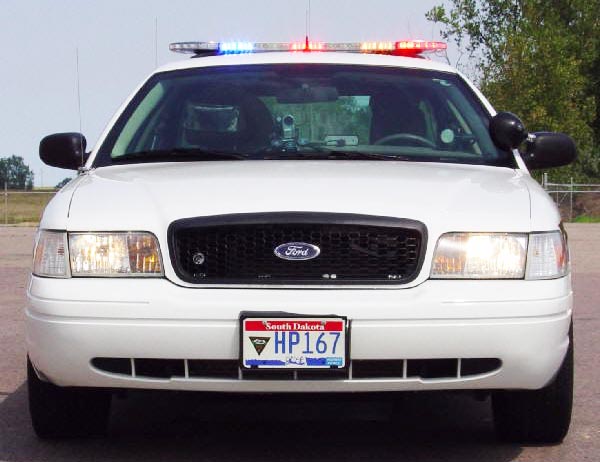
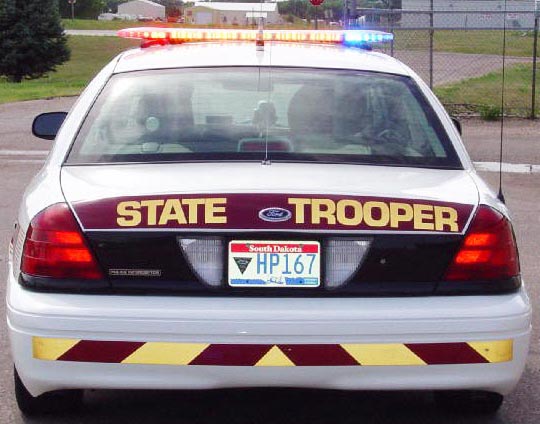
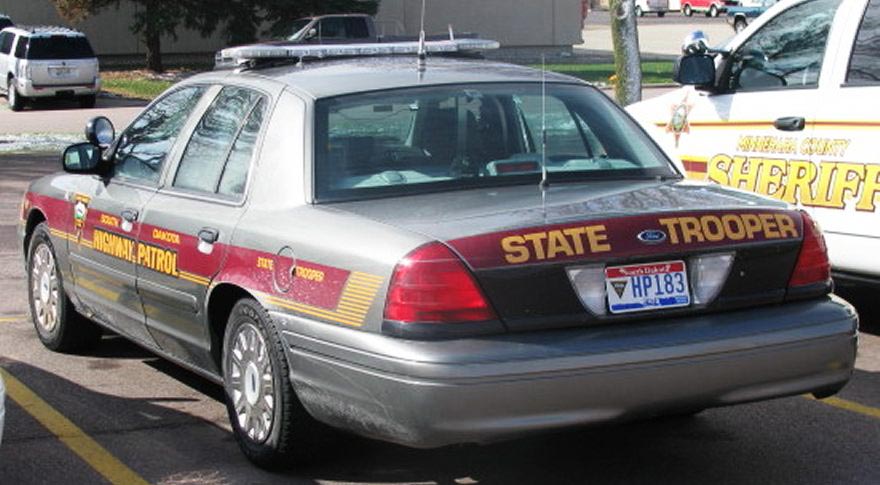
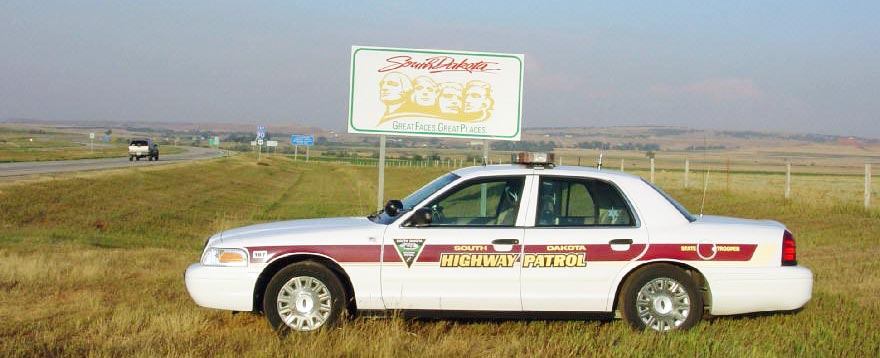
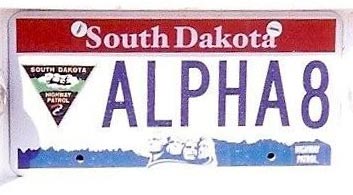 2000-2013 ALPHA issue.
2000-2013 ALPHA issue. 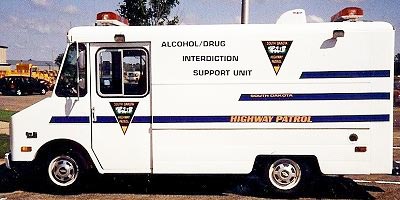 ALPHA 8 Chevrolet Step Van
ALPHA 8 Chevrolet Step Van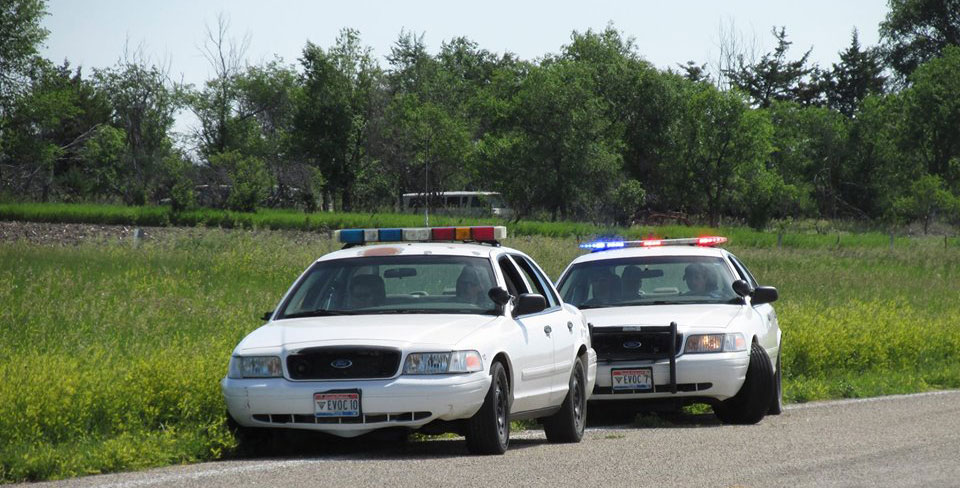 SDHP Emergency Vehicle Operators Course (EVOC) issues used on training vehicles.
SDHP Emergency Vehicle Operators Course (EVOC) issues used on training vehicles.Around 2012, the font style used for the all-silkscreened characters for the HP prefix and the assignment number were homogenized into one style.
In 2013, the South Dakota Highway Patrol launched a 75th Anniversary license plate to commemorate the occasion.
The plates have silkscreened white characters over a black background and still use the HP ### numbering sequence.
The state name is located at the top center of the plate silkscreened in gold script and 1938-2013 occupies the bottom center of the plate.
A stylized 75th anniversary emblem occupies the left center field of the plate.
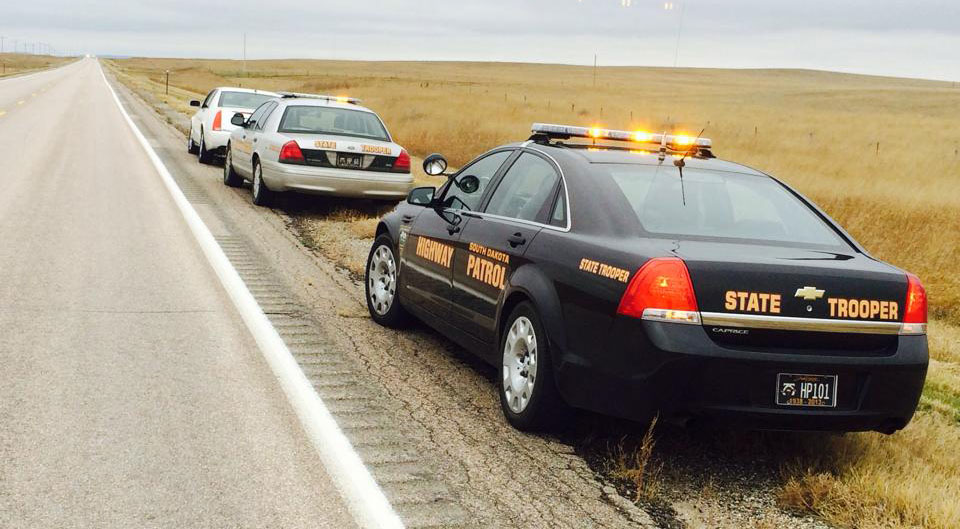
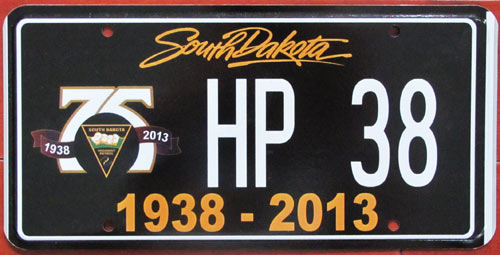 2013-2016 issue.
2013-2016 issue. 
On January 1 2016, the South Dakota Highway Patrol launched a newly-redesigned license plate for their fleet. The plate is entirely silkscreened with no embossed characters. The background of the plate features an open blue sky over the expanse of Mount Rushmore which occupies the bottom portion of the plate. A stylized state name appears in black at the top center of the plate and STATE TROOPER in black block font appears at the bottom center. A full color SDHP emblem occupies the left center of the plate followed by the HP prefix in black and a number up to three digits. Issued until 2023.
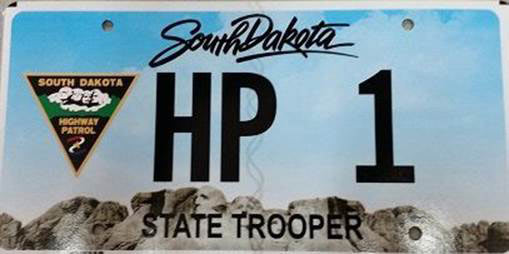 2016-2023 issue. All silkscreened.
2016-2023 issue. All silkscreened.
Sometime in late 2023, the South Dakota Highway Patrol underwent another license plate change.
The new design was once again an "all flat" silkscreened aluminum plate. This time a plain white over black color combination was used. The state name was in the same stylish cursive script at the top center of the plate. The SDHP emblem was once again at the center left field of the plate but without additional colors. The numerals beginning with the HP prefix occupied the center field of the plate.
STATE TROOPER was centered at the bottom of the plate between the lower mounting holes. The plate has an all-white section at the bottom left corner below the perimeter border line where a UPC code in black is situated. The background of the plate has a cursory sketch of Mount Rushmore.
 2023-current issue. All silkscreened.
2023-current issue. All silkscreened.
What little information there is about motorcycle use by the SDHP is that they typically used low numbered civilian motorcycle plates.
In 1970, a SDHP motorcycle was observed running a standard civilian South Dakota motorcycle license plate # 15. The embossed steel plate measured 3 1/4" x 7 1/2 and colored blue over reflective white. The number 15 was embossed over SO.DAKOTA 70.
A group photo of SDHP motorcycles taken in 1981 showed a similar plate used on all three bikes bearing numbers 18, 19 and 20.
 2016-2023 motorcycle issue.
2016-2023 motorcycle issue.
It's not often that we have trailer license plate usage by a state law enforcement agency on this site, but when the information comes in, it's worth mentioning.
The same SDHP motorcycle license plate from 1970 mentioned above was situated on a trailer bearing a South Dakota tax exempt trailer license plate number SH-1117 It is surmised that the SH stands for "State Highway".
In the early 1980's a SDHP portable scales unit for commercial vehicles used at a Port of Entry was observed bearing a standard South Dakota trailer license plate with a TE prefix (Tax Exempt) followed by a dash and four numbers.
The following are examples of specialty license plate types used either officially or unofficially for the South Dakota Highway Patrol.
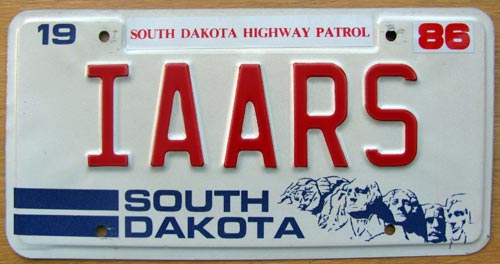 Souvenir plate issued to delegates who attended the 1986 International Association of Accident Reconstruction Specialists conference hosted by the SDHP that year.
Souvenir plate issued to delegates who attended the 1986 International Association of Accident Reconstruction Specialists conference hosted by the SDHP that year.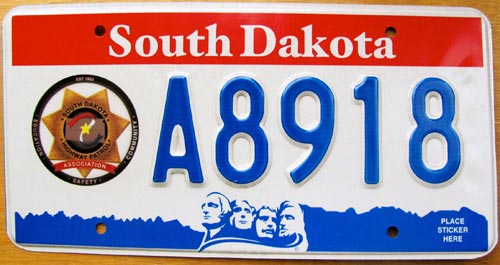 2000-Current South Dakota Highway Patrol Association license plate for personal vehicle use.
2000-Current South Dakota Highway Patrol Association license plate for personal vehicle use.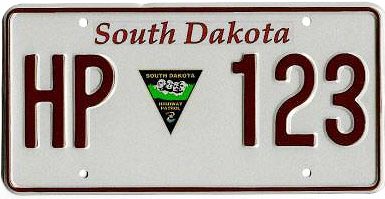 3M Prototype sample. Year unknown, but likely around 2000.
3M Prototype sample. Year unknown, but likely around 2000.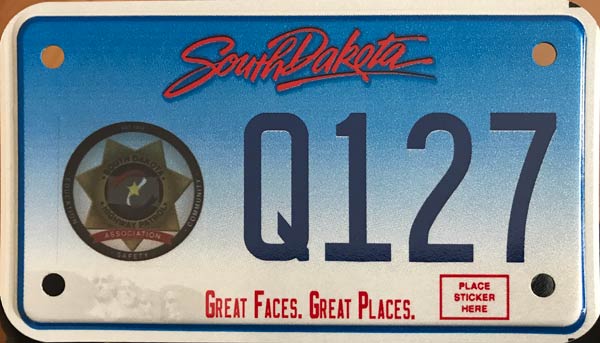 2016-Current SDHP Association Motorcycle issue.
2016-Current SDHP Association Motorcycle issue.